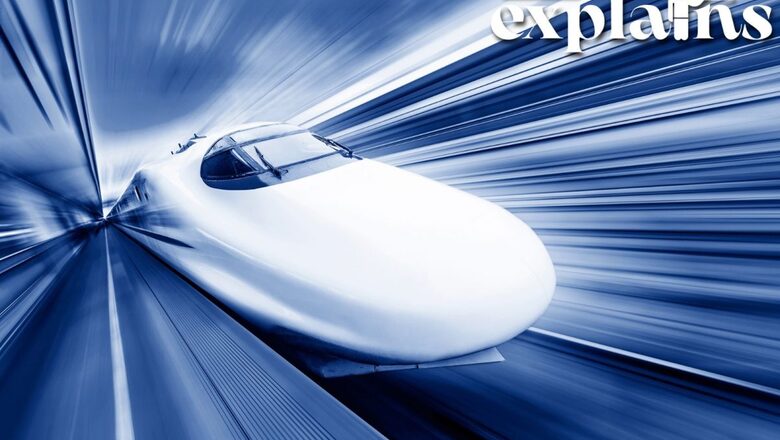
views
Declaring that the upcoming Mumbai-Ahmedabad bullet train project is of ‘national importance’, the Bombay High Court on Thursday dismissed a plea of Godrej & Boyce Manufacturing Co. challenging the acquisition of its land in Vikhroli. The verdict by a division bench of Justices R.D. Dhanuka and Justice M.M. Sathaye said: “The project is of national importance and public interest… No interference is required. No illegality found in the compensation.”
The judgement signalling a green flag came as a breather for the mega-project ahead of Prime Minister Narendra Modi’s visit to Mumbai on Friday.
Justices Dhanuka and Sathaye also said that it is the paramount collective interest that would prevail and not private interest “Project would be first of its kind. “Petition is dismissed”.
What is the Bullet Train Project?
The Mumbai-Ahmedabad High Speed Rail Corridor (MAHSR) or Mumbai-Ahmedabad HSR is a high-speed rail line under development that will connect India’s economic powerhouse Mumbai with the city of Ahmedabad. It will be India’s first high-speed rail route when completed.
Catch a glimpse of the real-time progress on the first River Bridge (320 m) at MAHSR Corridor. pic.twitter.com/1UChboKX41— Ministry of Railways (@RailMinIndia) January 24, 2023
To Have First Under-Sea Tunnel
Work on the BKC station, connecting Bandra-Kurla Complex (BKC) and Shilphata in Maharashtra has also begun, reports said. It will be the sole underground station on the Mumbai-Ahmedabad High-Speed Rail Corridor.
According to the Mumbai-Ahmedabad High-Speed Rail project, 21 km of the total 508.17 km of rail track will be underground, with the remainder elevated. The tunnel will safeguard the bird sanctuary and mangroves surrounding Thane Creek.
“The seven-km undersea tunnel at Thane Creek will be the first undersea tunnel to come up in the country. It will be a single tube tunnel to accommodate twin tracks for both-up and down. Apart from this, 39 equipment rooms at 37 locations will also be constructed adjoining the tunnel location as part of the package,” National High-Speed Rail Corporation Limited (NHSRCL) Chief Project Manager UP Singh Singh told News18 in an exclusive interview. Read the full interview here
“Dedicated skylight provisions have been made for natural lighting. The amenities planned for passengers at stations include security, ticketing, waiting areas, business-class lounge, nursery, rest rooms, smoking rooms, information kiosks and incidental retail, public information and announcement system and CCTV surveillance,” he added.

The tunnel will be 25-65 metres below ground, with the deepest construction site 114 metres below the Parsik hill near Shilphata in Maharashtra. India is building this tunnel using cutting-edge technology such as the New Austrian Tunnelling Method.
About the Bullet Train Project
The project will include four stations in Maharashtra (BKC), Thane, Virar, and Boisar, as well as eight stations in Gujarat (Vapi, Bilimora, Surat, Bharuch, Vadodara, Anand/Nadiad, Ahmedabad, and Sabarmati).
The corridor is 508 kilometres long in total, including 156 kilometres in Maharashtra, four kilometres in Dadra Nagar Haveli, and 384 kilometres in Gujarat, Singh told News18. The maximum operational speed will be 320 kmph, with a total travel time of 2.58 hours. There will be three depots: one in Thane, Maharashtra, and two in Gujarat, Surat and Sabarmati.
Bullet Trains Around the World
In 1964, Japan’s Tkaid Shinkansen, or “bullet train,” became the world’s first high-speed rail line, reaching speeds of more than 124 mph (200 km/h), according to a report by Visual Capitalist.
Japan spearheaded the high-speed train revolution, and it remains at the top of the rankings. Though its fastest normal running bullet trains (the N700A Shinkansen) can achieve 186 mph or 300 km/h, the country’s new magnetic levitation (maglev) development is surpassing speed records.
Indeed, the world’s top two fastest trains are maglev, which use two sets of magnets to elevate the train and propel it forward without friction to slow it down, the report says. Japan’s L0 Series Maglev is still in production, but it has the world’s fastest train with a land speed record of 374 mph or 602 km/h.
The report by Visual Capitalist also encapsulates the fastest bullet trains and their speeds, around the world:
Special Mentions:
L0 Series Maglev
The Central Japan Railway Company (JR Central) is currently developing and testing this Japanese train, which has a land speed record for rail vehicles of 374 mph, according to a report by Travel and Leisure.
The SCMaglev is a magnetic levitation (maglev) railway system developed by Central Japan Railway Company and the Railway Technical Research Institute. On 21 April 2015, a manned seven-car L0 Series SCMaglev train reached a speed of 603 km/h (375 mph) https://t.co/ZsMjTmNk9h pic.twitter.com/8Ek83Z6NON— Massimo (@Rainmaker1973) October 27, 2019
This train is currently being constructed for regular commercial use. The first phase (Tokyo to Nagoya) is scheduled to open in 2027, followed by Osaka. When finished, the L0 Series will have a top speed of 310 mph, allowing it to travel from Tokyo’s Shinagawa Station to Osaka (a distance of over 300 miles) in one hour and seven minutes.
The L0 Series technology, known as maglev (magnetic levitation train), causes the train to float at speeds of up to 93 mph.
China’s CRH380A
While China’s CRH380A Hexie (also known as Harmony) has a commercial maximum speed of 236 mph, it hit a remarkable 302 mph during testing. The high-speed electric train is one of four Chinese train series designed to operate on freshly constructed high-speed main lines.
#いいねした鉄道ファン全員フォローする #RTした鉄道ファン全員フォローするCRH380A 重联型 正线全速通过 pic.twitter.com/pOn0GYUrjG— 番茄炒蛋蛋喵 (@egg_tomatos) August 10, 2020
The CRH380A is the fastest, the other three are CRH380B, CRH380C, and CRH380D.
Frecciarossa 1000
El frecciarossa 1000 saliendo del taller de Santa Catalina. pic.twitter.com/fTPLeL2tBJ— Niyes (@Niyess) May 3, 2022
Italy’s Frecciarossa 1000 (also known as ETR 400) runs at breakneck speeds through cities including Milan, Florence, Rome, and Venice, the report says. While trains in Italy are limited to 190 mph, the Frecciarossa 1000 reportedly hit a top speed of 245 mph (393.8 km/h) in 2016.
Read all the Latest Explainers here



















Comments
0 comment